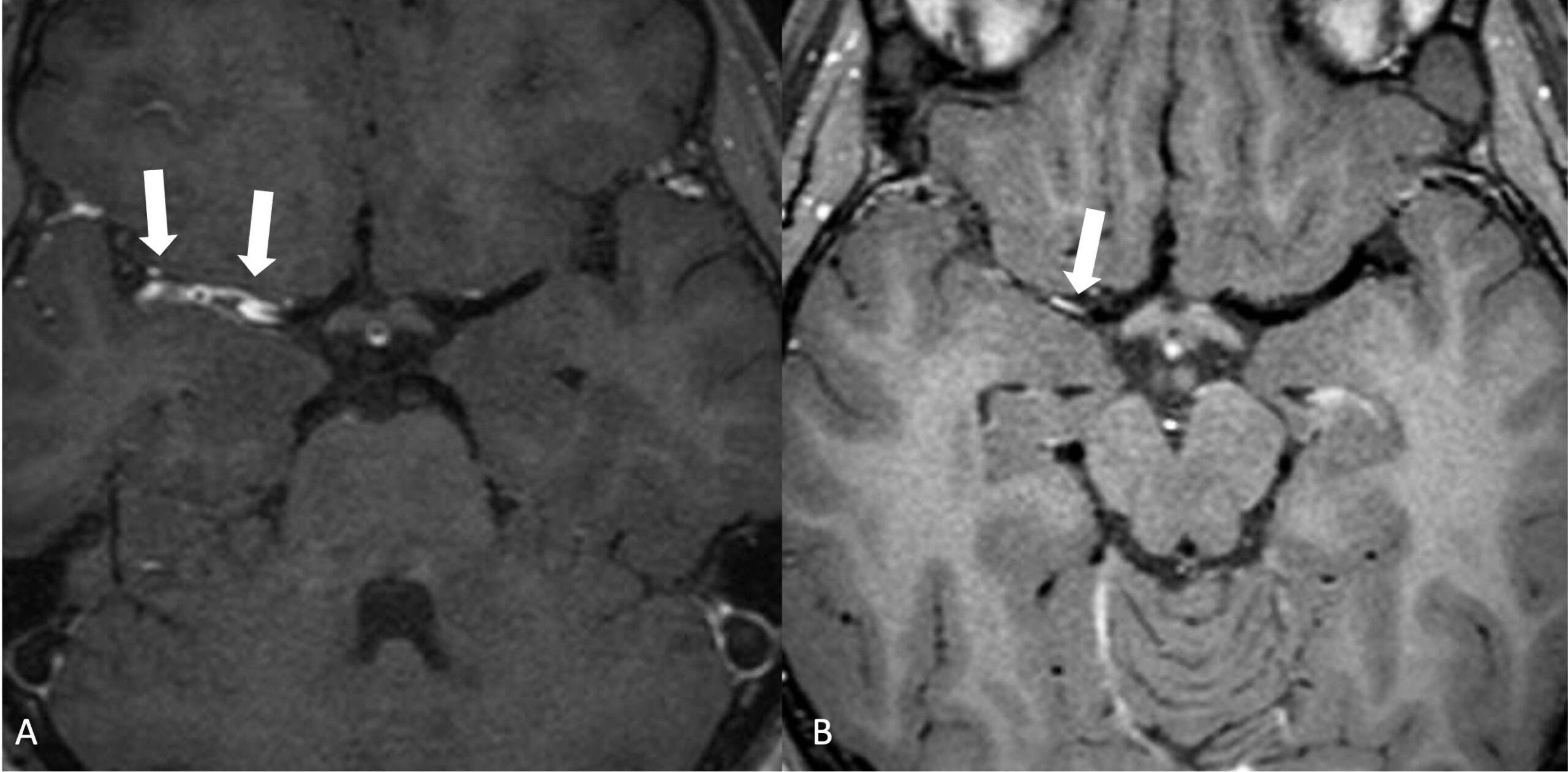
Associating ophthalmic herpes zoster with cerebral vasculitis
Herpes zoster ophthalmicus is associated with vasculopathy and cerebral infarction and has significant morbidity and mortality when untreated
10/07/2023
Axial diffusion-weighted images (DWI) showing right basal ganglia, internal capsule, and deep white matter hyperintensity (arrows), which had corresponding hypointensity on the apparent diffusion coefficient (ADC) map (not shown)
Hyperintense areas in bilateral suprathalamic regions on diffusion-weighted B1000 sequence and hypointense areas consistent with diffusion-limiting ischemia in bilateral suprathalamic regions in diffusion-Paiva JLR et al. – Herpes zoster ophthalmicus and cerebral vasculitis
Jean Levi Ribeiro de Paiva[1], Tânia Aparecida Marchiori de Oliveira Cardoso[2] and Fabiano Reis[1]
[1]. State University of Campinas, Department of Anesthesiology, Oncology and Radiology, Campinas, SP, Brazil.
[two]. State University of Campinas, Department of Neurology, Campinas, SP, Brazil.
Corresponding author : Dr. Jean Levi Ribeiro de Paiva. email: jeanlevirp@gmail.com
Authors’ contribution
JLRP: data acquisition and initial writing of the manuscript.
TAMOC : critical review of the manuscript for intellectual content.
FR: study design, data acquisition and critical review of the manuscript for intellectual content.
Conflict of interests
The authors declare no conflict of interest.
Financial help
There was no financial support for the preparation of this article.
orcid
Jean Levi Ribeiro de Paiva: https://orcid.org/0000-0002-8109-9377
Tânia Aparecida Marchiori de Oliveira Cardoso: https://orcid.org/0000-0002-4565-3035
Fabiano Reis: https:// orcid.org/0000-0003-2256-4379
A 15-year-old boy presented with fever for 50 days, edema and hyperemia in the right eyelid and visual deficit diagnosed as chorioretinitis. One month later, the patient developed a brief episode of left hemiparesthesia and, subsequently, sudden paresis of the left upper and lower limbs without skin lesions. Analysis of the cerebrospinal fluid (CSF) revealed pleocytosis with a predominance of lymphocytes, restricting the differential diagnosis to viral infections, syphilis, inflammatory and autoimmune diseases. The last three were deemed unlikely after extensive laboratory analysis.
Magnetic resonance imaging (MRI) revealed lesions in the right basal ganglia, internal capsule and deep white matter with restricted diffusion, compatible with acute ischemic stroke ( Figure 1 ). Time-of-flight three-dimensional magnetic resonance angiography showed a lack of flow signal in the right middle cerebral artery ( Figure 1 ), and high resolution imaging of the vessel wall (HR-VWI) revealed concentric wall thickening with contrast enhancement in the right side Segments M1 and M2, indicating vasculitis ( Figure 2 ). Subsequent CSF analysis revealed elevated levels of IgG to the varicella zoster virus, and the patient was treated with acyclovir for 14 days. After treatment, HR-VWI showed a marked reduction in wall enhancement ( Figure 2).
weighted MR ADC sequence
Ophthalmic herpes zoster is associated with vasculopathy and cerebral infarction and presents significant morbidity and mortality when left untreated. Consequently, rapid diagnosis is crucial, but it can be very challenging, especially in the absence of typical skin lesions. In this context, MRI is a useful tool for diagnosing stroke and observing infectious vasculitis1,2,3.
Thanks
We offer our deepest thanks to the institutions that provided technical support for the development and implementation of this study.
References
1. Maher MD, Douglas VP, Douglas KAA, Collens SI, Gilbert AL, Torun N, et al. Clinical and neuroradiological features of varicella zoster virus reactivation with central nervous system involvement. J Neurol Sci. 2022;437:120262.
2. Lau A, Essien EO, Tan IJ. Zoster sine herpete masquerading as central nervous system vasculitis. Healed. 2020;12(3):e7231.
3. Feitoza LM, Stucchi RSB, Reis F. Neurosyphilis vasculitis manifesting as ischemic stroke. Rev Soc Bras Med Trop. 2020;53:e20190546.

FIGURE 1: A and B. Axial diffusion-weighted images (DWI) showing right basal ganglia, internal capsule, and deep white matter hyperintensity (arrows), which had corresponding hypointensity on the apparent diffusion coefficient (ADC) map (not shown ). This indicates restricted diffusion, consistent with acute ischemic stroke. C. Time-of-flight three-dimensional magnetic resonance angiography (3D-TOF) showing no flow signal in the right middle cerebral artery from its origin (arrow).

FIGURE 2: A. High-resolution axial post-contrast-enhanced image of the vessel wall (HR-VWI) showing irregular concentric parietal thickening and enhancement of the M1 and M2 segments of the right middle cerebral artery, consistent with vasculitis (arrows). B. Contrast-enhanced axial HR-VWI 17 months after antiviral treatment, showing marked reduction in parietal thickening of the vessel wall, with mild parietal enhancement, possibly related to sequelae of the infection (arrow).










